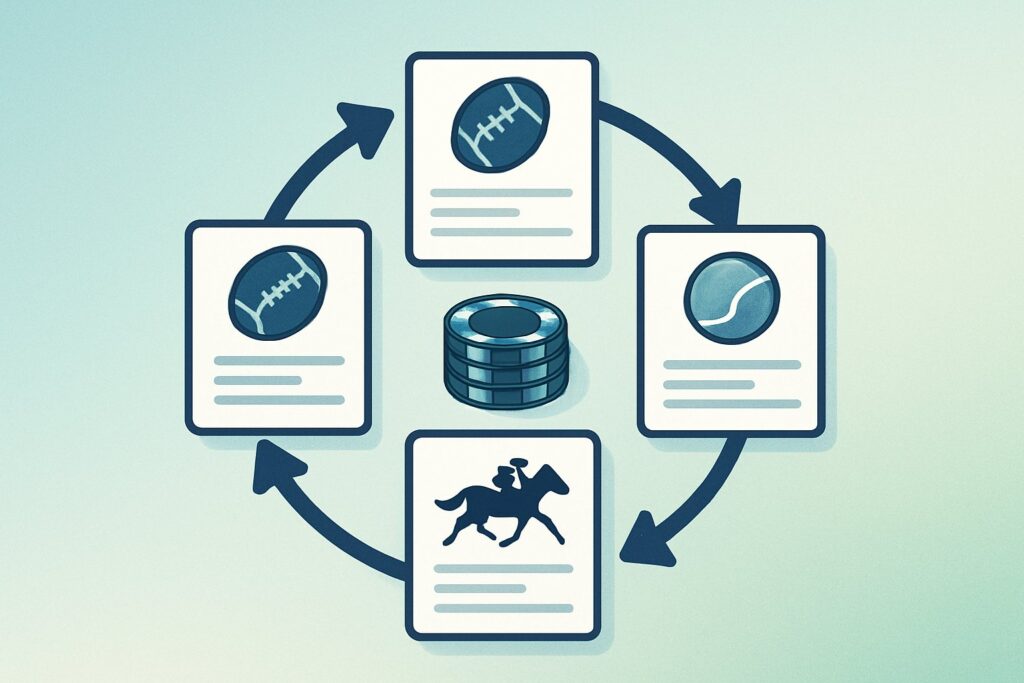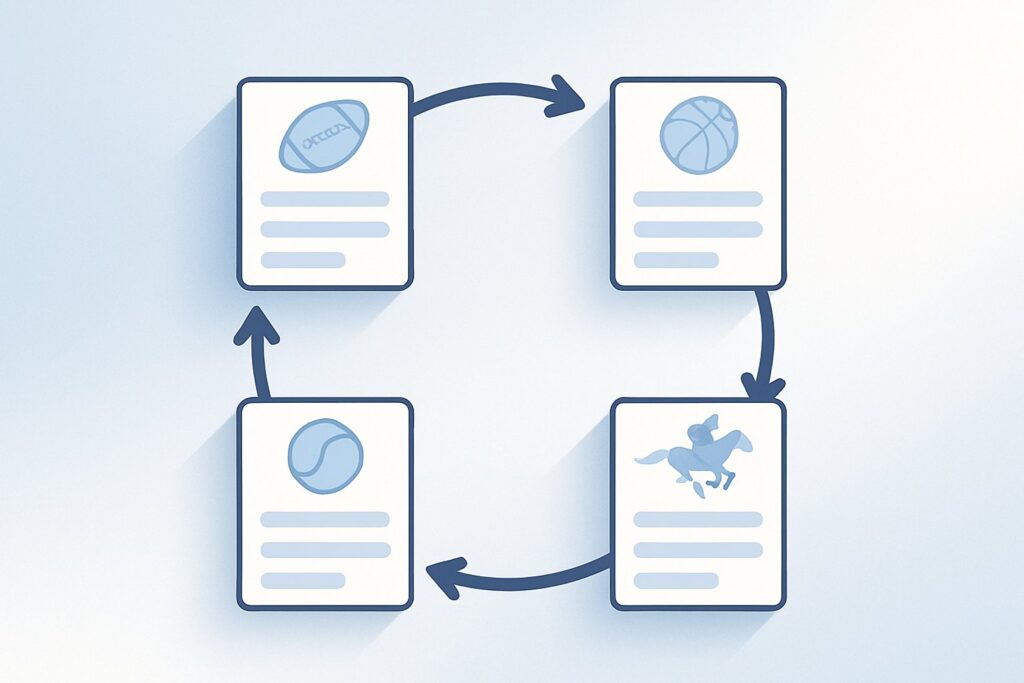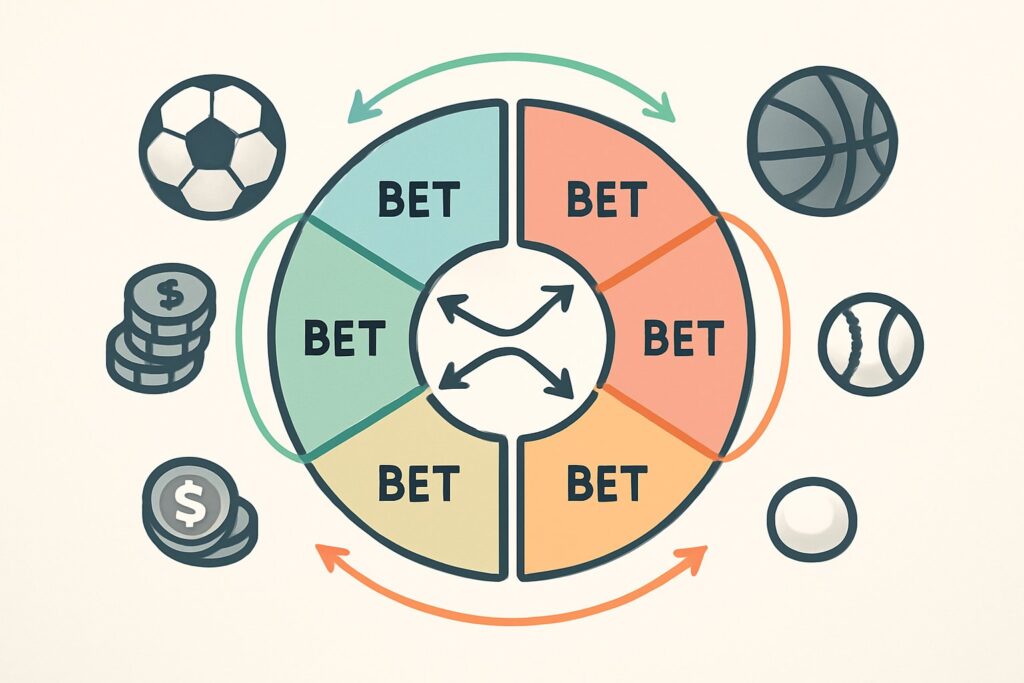by Martin Green
August 9, 2025
Last Updated on August 9, 2025 by Martin Green
Round robin bets let you spread out your risk but still chase a good payout. Instead of putting everything into one big parlay that’s dead if a single pick fails, you break your selections into smaller parlays covering every possible combo. This way, you’ve got more chances to win, even if not all your picks land.

You can use round robin bets in just about any sport – football, basketball, whatever you’re into – and tweak the setup to match your appetite for risk. By picking how many teams to group together in each mini-parlay, you control both the cost and your potential payout. This flexibility makes round robins appealing if you want action on several outcomes but aren’t into the all-or-nothing stress of a classic parlay.
Sportsbooks make placing a round robin easy. Just pick your bets, choose the combo size, and let the system do the rest. Once you get how the payouts work, you’ll know when this bet type fits your approach.

With a round robin bet, you place a bunch of smaller parlays from one group of picks. This spreads out your risk and gives you more chances to win than a regular parlay. You pick the games, and the sportsbook handles the combinations.
To make a round robin, you need at least three selections. These could be moneylines, spreads, totals, or whatever you like.
The bet splits your picks into smaller parlays, like 2-leg or 3-leg combos. Each combo is its own bet with its own stake and payout.
Say you’ve got three teams—A, B, and C—and you go “by 2s.” You’ll get:
| Combo # | Teams in Parlay |
|---|---|
| 1 | A + B |
| 2 | A + C |
| 3 | B + C |
Your payout depends on how many of these parlays hit. One loss doesn’t always kill your whole round robin.
With a traditional parlay, you lump all your picks into one bet. Every pick has to win, or you get nothing.
Round robins take a different route. They build multiple parlays from your picks, so you can still win something even if a few don’t come through.
Here’s a quick side-by-side:
| Feature | Parlay | Round Robin |
|---|---|---|
| Risk | Higher | Lower |
| Payout Potential | Higher (all win) | Moderate |
| Number of Bets | 1 | Multiple |
| Can Win with Losses? | No | Yes |
So, a round robin sits somewhere between single bets and full parlays.
Benefits:
Drawbacks:
Stick to picks you’d bet on their own, and always check your total stake before locking in a round robin.

Round robin bets break your picks into smaller parlays. This spreads your risk across different combos, so if not every pick wins, you might still cash something. You decide the size of each parlay and how much to risk overall.
Start with at least three selections. The sportsbook creates multiple parlays from your picks.
With three teams, if you choose “by 2s,” you’ll get three separate 2-leg parlays. Each one is its own bet with its own payout.
The total number of bets depends on:
| Number of Picks | Combo Size | Total Bets |
|---|---|---|
| 3 | 2-leg | 3 |
| 4 | 2-leg | 6 |
| 4 | 3-leg | 4 |
You pay for each parlay. If you stake $10 per combo and have six combos, you’re putting up $60 total.
Let’s say you pick:
A 2-leg round robin gives you:
If you bet $50 per parlay, your total bets come to $150.
This setup gives you more shots to win than a single parlay that needs every pick to hit.
One of the main perks of round robins is partial payouts. Unlike a parlay, a single loss doesn’t always kill your chances.
If some combos win, you still get paid for those. This cuts down your total loss compared to an all-or-nothing parlay.
The flip side? You’re placing more bets, so your total stake rises. You have to weigh the lower risk of losing everything against the bigger upfront cost.
A round robin bet splits your group of picks into smaller parlays. You pick the teams or outcomes, decide how many legs to put in each parlay, and then the sportsbook creates every possible combo. You pay for each parlay, and what you win depends on which combos hit.
Start by picking at least three teams or outcomes you want to include. Most sportsbooks will let you add more, but three’s the minimum.
Then, choose the size of each parlay. If you pick four teams, you can make 2-team parlays, 3-team parlays, or both.
The sportsbook will generate all the combos. For example:
| Selection Count | Parlay Size | Number of Parlays |
|---|---|---|
| 3 picks | 2-team | 3 |
| 4 picks | 2-team | 6 |
| 4 picks | 3-team | 4 |
Check the total cost. Each parlay is a separate bet, so the total stake is stake per parlay x number of parlays. Only go ahead if it fits your budget.
Add multiple selections to your bet slip on a site like BetOnline, and you’ll see options for singles, parlays, and round robins.
Click the “Round Robin” tab or checkbox. Pick your parlay size (like 2-pick or 3-pick). The slip shows how many parlays you’re placing and the cost per parlay.
You can set the stake for each parlay or make them all the same. The slip updates the total automatically.
Double-check your picks, stakes, and payout estimates before confirming. Once you place the bet, each parlay shows up as a separate wager in your account.
Lots of offshore sportsbooks work pretty much the same way, but layouts and wording vary. Some use drop-downs instead of tabs for round robin options.
Sometimes you have to pick the combos yourself instead of the site doing it automatically. That can be handy if you only want certain parlays.
Offshore sites might show potential payouts for each parlay, or just the total stake and possible combined return. Always check the interface closely so you know what you’re betting and what it’ll cost.
You can build round robin bets from different formats, depending on how many picks you have and how you group them. Knowing these structures helps you decide how much risk – and money – you want to put in.
In a round robin, you can make 2-leg and 3-leg parlays from your picks.
A 2-leg parlay links two picks. Both have to win for you to get paid. In a round robin, you’re placing several 2-leg parlays using different combos of your picks.
A 3-leg parlay ties together three picks. All three need to hit for a payout. These usually offer better odds than 2-leg parlays, but they’re riskier.
For example, if you choose four teams, the round robin can generate:
| Parlay Type | Number of Combos |
|---|---|
| 2-leg | 6 |
| 3-leg | 4 |
Since each combo is a separate bet, your total stake is the stake per parlay times the number of combos. Costs can add up fast if you’re not careful.
A Trixie uses 3 selections to make 4 bets: 3 doubles and 1 treble. Singles aren’t part of a Trixie.
A Patent also uses 3 selections but adds singles, so you get 7 bets: 3 singles, 3 doubles, and 1 treble. This helps if just one pick wins.
A Yankee uses 4 selections and creates 11 bets: 6 doubles, 4 trebles, and 1 four-fold accumulator. No singles here either.
| Format | Selections | Total Bets |
|---|---|---|
| Trixie | 3 | 4 |
| Patent | 3 | 7 |
| Yankee | 4 | 11 |
People use these formats a lot in round robins because they give you more ways to win, even if not every pick comes through.
Round robin bets really shine in sports with lots of games happening at once and straightforward betting markets. They’re popular when you can mix up bet types like spreads, moneylines, and totals into smaller parlays.
The NFL is a favorite for round robin betting. Each week, there are plenty of games and a wide range of odds. You can pick a few matchups and make combinations that can still cash even if one team lets you down.
Let’s say you pick 3 NFL teams on the moneyline. The sportsbook creates three 2-team parlays from your picks. You could also throw in some point spreads or totals.
NFL round robins are popular for a few reasons:
If you’ve got a late-game favorite in your round robin, you can bet the other side before kickoff to guarantee a profit if your earlier combos already hit. It’s a handy trick when you’re ahead.
You can build round robins with all sorts of markets. Moneyline bets are simple – just pick who’ll win. A lot of people mix favorites and underdogs to balance risk.
Totals (over/under) let you bet on the combined score. Adding totals means you’re not only relying on picking winners.
Underdogs can really boost your payout. If you hit even a couple of underdog legs, the bet can turn a profit. Many folks mix a few underdogs with safer picks, hoping for that one upset.
A basic mix might look like this:
| Leg Type | Example Pick | Odds |
|---|---|---|
| Moneyline | Team A to win | -150 |
| Total | Over 45.5 points | -110 |
| Underdog | Team B to win | +200 |
Round robin bets let you avoid losing everything on one parlay while still chasing a decent payout. To get the most out of them, you’ve got to manage your stake sizes, pick your spots, and steer clear of mistakes that can eat up your bankroll.
Since a round robin creates several parlays from your picks, costs can climb fast. Decide upfront how much you’re willing to risk on the whole set of bets.
For example, if you want to risk $50 total and your round robin has 10 combinations, you’d put $5 per parlay. If you accidentally bet $50 per parlay, you’d risk $500 instead. Ouch.
Try sticking to a set percentage of your bankroll – maybe 1-3% per round robin – to keep things under control. That way, you’re not out of the game after a bad run.
It helps to keep a simple log: note your stake per combo, total risk, and what you win or lose. Over time, you’ll spot trends and can tweak your bet sizes.
Round robins work best when your picks have longer odds or you think you’ll hit some, but not all. They’re great for underdogs or unpredictable markets.
For example, if you pick six underdogs and spread them into smaller parlays, you might only need two or three upsets to break even or turn a profit. It depends on the odds, but you don’t need to sweep the board.
They’re also handy for hedging. If your last leg is a big favorite in a late game, you can bet the other side after earlier wins to lock in a profit, no matter what happens.
It’s usually not worth using round robins for heavy favorites with tiny payouts – unless you’ve got a specific hedge in mind.
A lot of people underestimate the total stake. Always check the total risk before you hit confirm, since each parlay in the round robin is its own bet.
Another pitfall is loading up on too many low-value picks. If most legs have short odds, the payouts probably won’t be worth it for the number of combos you’re playing.
Don’t fire off round robins too often without a plan. They cost more than a single parlay, so random use can drain your bankroll before you know it.
And just because they spread out risk, don’t think of them as “safe.” You still need to win a good chunk of your picks to come out ahead.
A round robin bet lets you build several smaller parlays from a group of picks. This setup can lower your risk compared to a big parlay and still give you a shot at a payout if not all your choices win.
It works best if you understand how the combos are made, how payouts work, and how your number of picks affects cost and possible return.
You start with at least three selections. The sportsbook automatically makes smaller parlays from your picks, like all possible 2-leg or 3-leg combos.
Each combo is its own bet. If a parlay hits, you win that payout, even if others lose.
The biggest plus is lower risk. One bad pick won’t sink your whole ticket, and you can still get something back.
The downside? You’re making several bets at once, so the cost is higher. If most picks miss, you might lose more than with a single parlay.
Say you pick Team A, Team B, and Team C, and choose a “by 2s” round robin. The system creates three 2-leg parlays: A+B, A+C, and B+C.
If you bet $10 on each, your total stake is $30. You get paid for each parlay that wins.
Start by checking the odds for each parlay. Multiply your stake for that combo by the combined odds to get the possible return.
Add up the payouts from all winning parlays. Each one settles on its own.
Most bettors stick to picks they’d bet on individually. That way, you’re not forcing risky combos.
Some people limit the number of legs per parlay to keep costs down and boost the odds of at least one win. Tracking results over time helps you fine-tune your approach.
Adding more selections means you end up with more parlay combinations. Your total stake goes up, but you also get extra shots at a win.
But if you go overboard with picks, costs can spiral and it gets tougher for enough combos to actually win and cover what you put in.